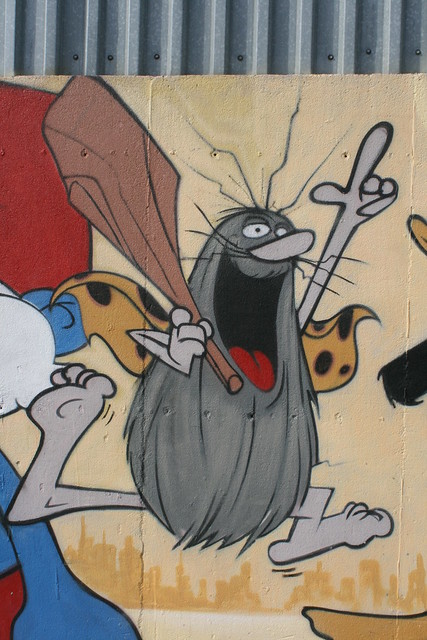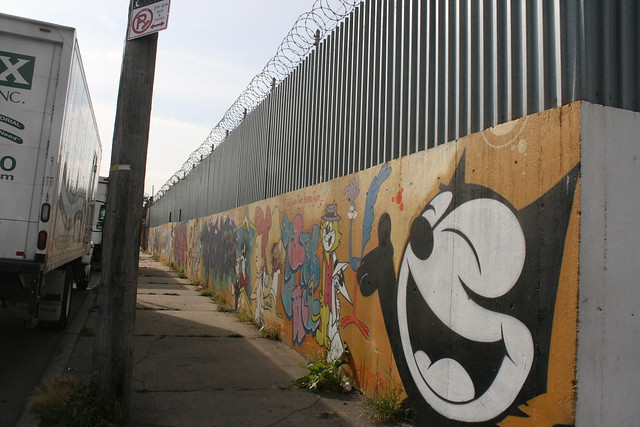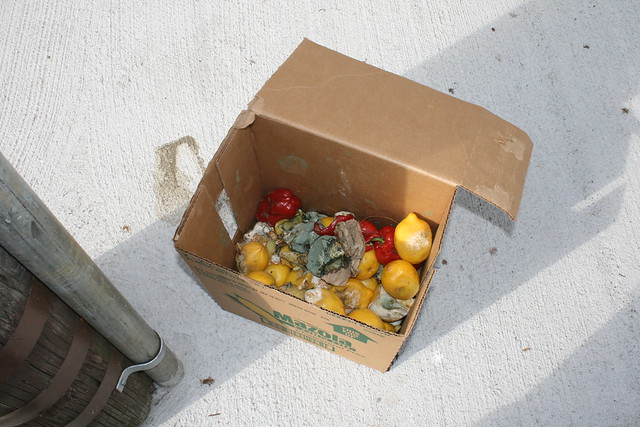So WFUV's Robin Shannon got wind of my work on
graffiti, and has asked me to talk to her, along with two others, about the difference between street art and graffiti for a show called Fordham Conversations. It’s an honor to be
thought of when it comes to a topic like this, considering how many folks there are out there who can speak authoritatively on the topic.
Anyway, I was hedging as to whether to lend my voice to the
project, and then went for a nice fast three mile run last night. Talk about
a whirlwind of thoughts that crossed my mind!
Now, before I try to answer the question, I must note that Banksy is in town this month, promoting a show in rather hilarious fashion:
Putting up pieces of “graffiti, which is latin for graffito, with an I,” along
with a phone number leading to a recording that excoriates the hoity toity-ness
of the art world. How fortuitous it is to talk about the difference between
“street art” and graffiti when the most famous “street artist” is referring to
his piece as graffiti?
Right, so there’s a couple of answers I would give, in no
particular order.
Q: What’s the difference between street art and graffiti?
A: Well, that depends. In 1964, Supreme Court Justice Potter said:
I shall not today attempt further to define the kinds of material I
understand to be embraced within that shorthand description ["hard-core
pornography"]; and perhaps I could never succeed in intelligibly doing
so. But I know it when I see it, and the motion picture involved in this case is not that.
You could say the same thing for art, and as I discovered in my interviews, you could interview ten different people about a mural, and get ten different opinions about whether it was any good, or if it was even art, and not vandalism. A better question might be, is it vandalism, or art?
 |
| Graffiti? Yeah, probably |
A: To a cop, nothing. If it's illegal, it's illegal, and you can be arrested for it. To a building owner, also, nothing. I've seen countless times where owners buff art that has no relation to the traditional tags, throw ups and pieces that define what the public considers to be graffiti.
 |
| Alas, gone from Red Hook |
 |
| Does that look like spray paint to you/? |
 |
| Say hello to my little friend, Queens |
A. Graffiti is done in poor areas; street art is done in rich areas. Ah, now this is more interesting, isn't it? I can't say I've been to a ton of poor neighborhoods in New York, but when I think of the few that I have been to, there is something to this. You can find lots of graffiti and street art in wealthy places like SoHo and DUMBO, for instance, but head up to Hunts Point in the Bronx or out to Jamaica, Queens, and you can be pretty certain that the only adornment you'll find will be traditional spray paint-based graffiti. To every rule there is an exception, of course; I've seen RAE sculptures in the not quite gentrified area of Bed-Stuy.
Which brings me to my final possible answer:
A: Graffiti is local; street art is international. Eh, sort of? It's awfully hard to make that case when an art form (graffiti) that started locally has gone world wide, and artists regularly travel here from across the globe to ply their craft on NYC walls. I would venture that in areas that are low visibility, either geographically (Hello Staten Island!) or socio-economically, graffiti, in the traditional sense, is the outlet of choice. If you're aspiring to be the next big thing in street art, you're not going to plant your artistic flag on Third Avenue in Sunset Park, but if that's your neck of the woods and you're searching for an outlet to make your mark, well, there are tons of nooks and crannies beneath the BQE over there.
Stay tuned for more on Fordham Conversations. Can't wait!




